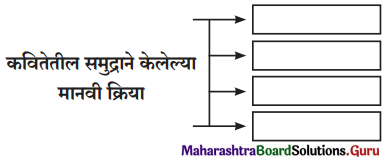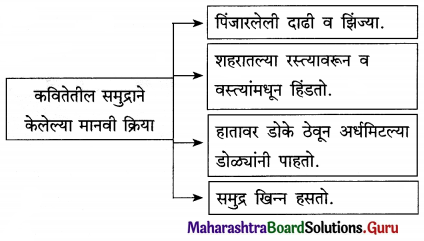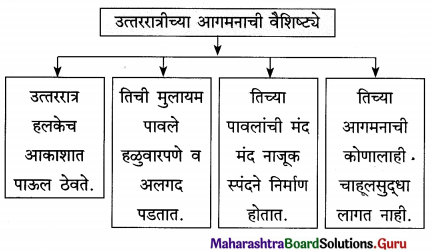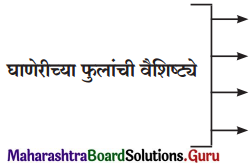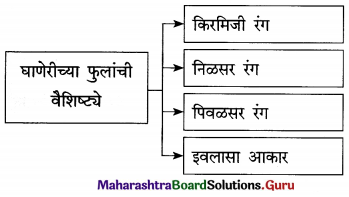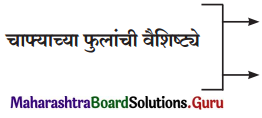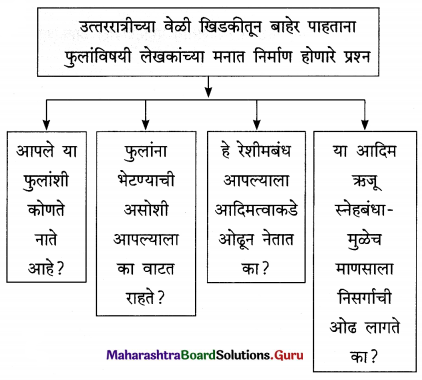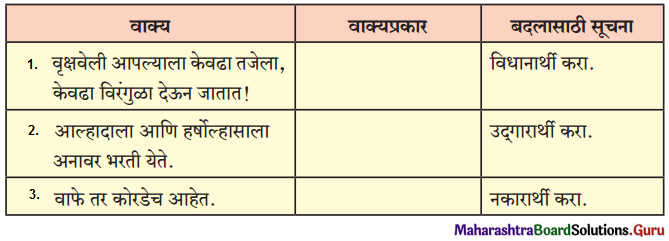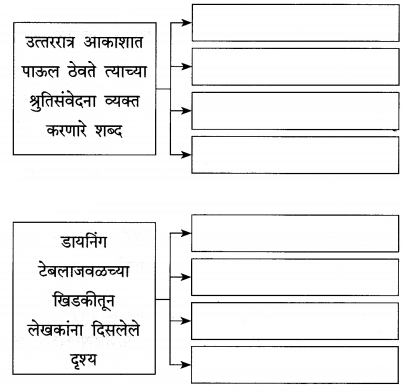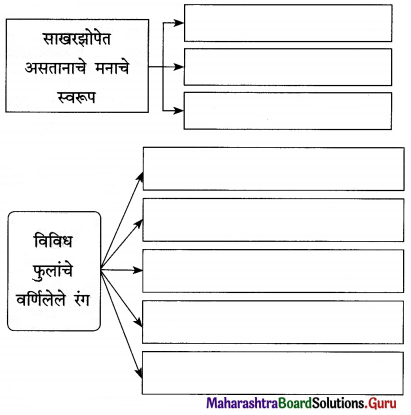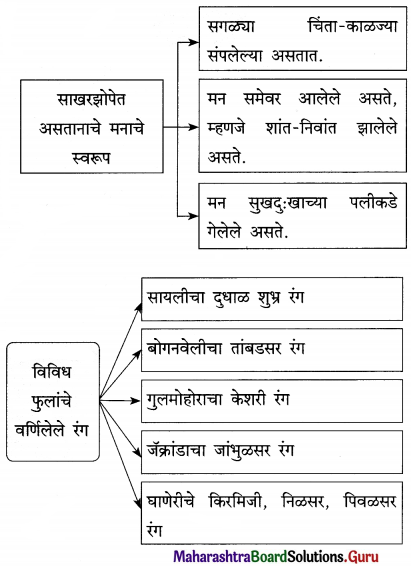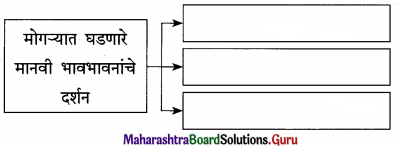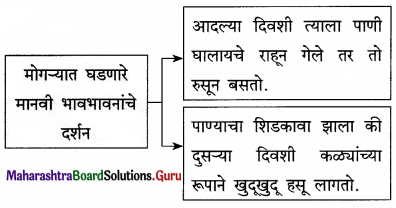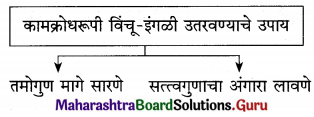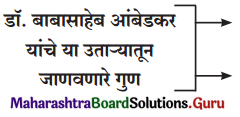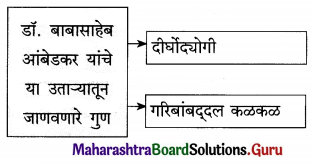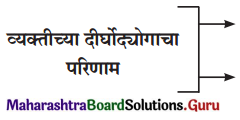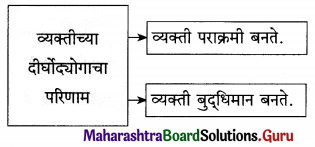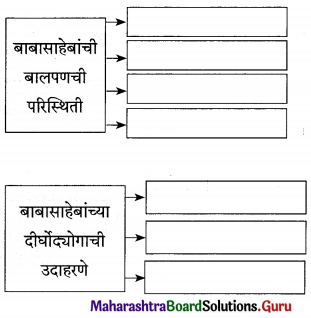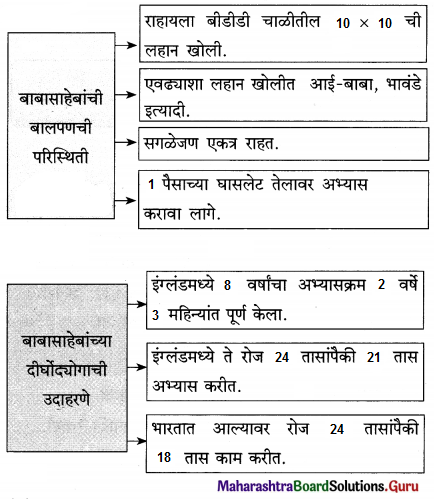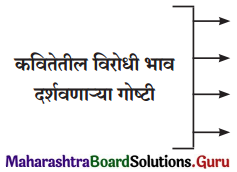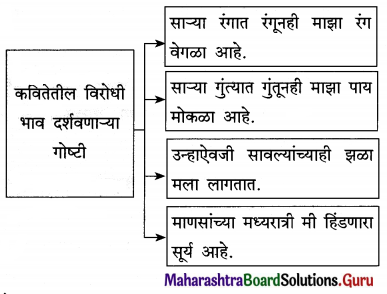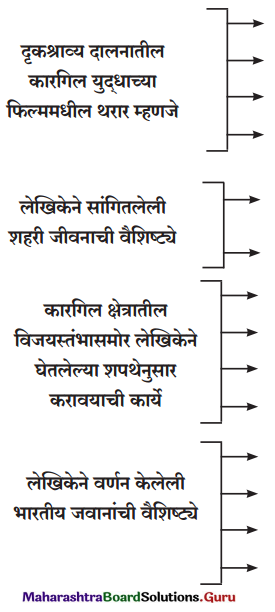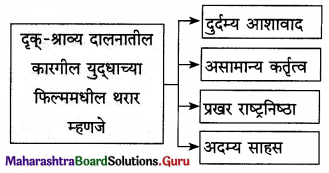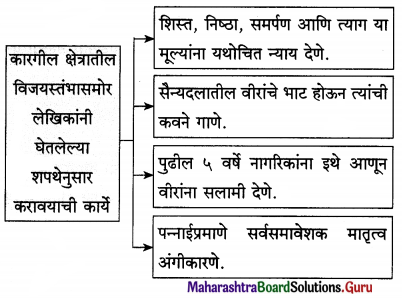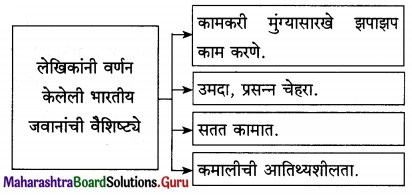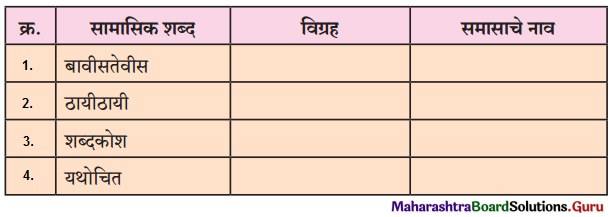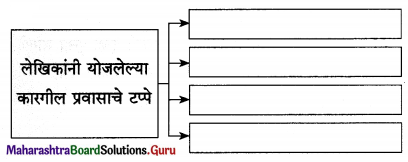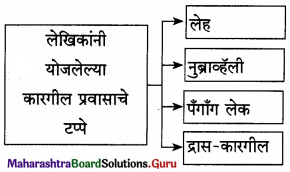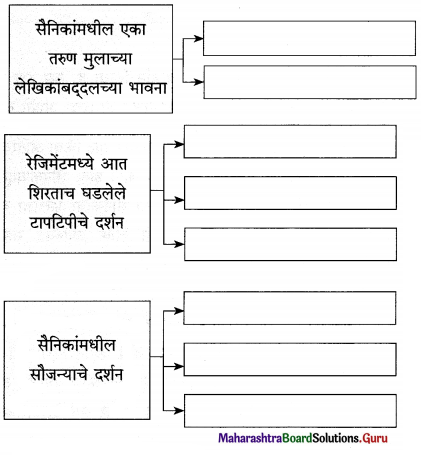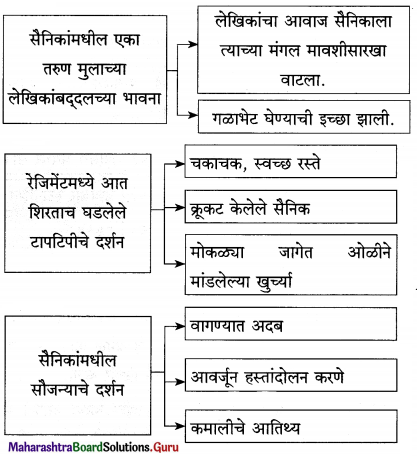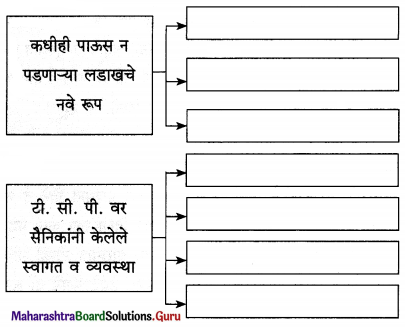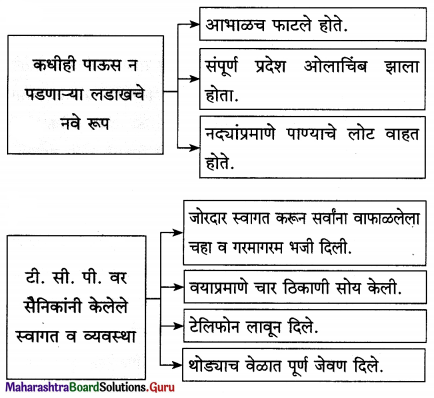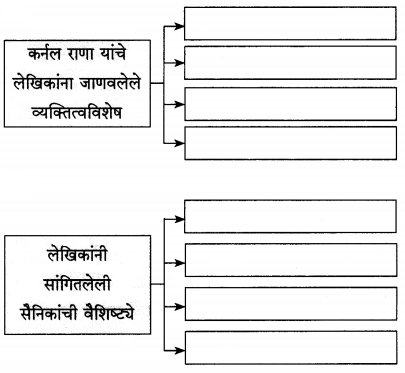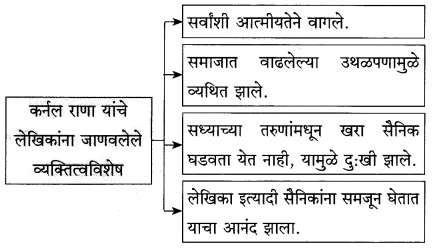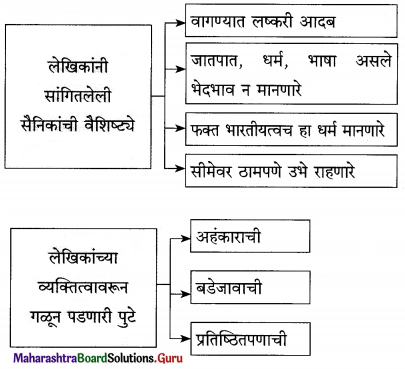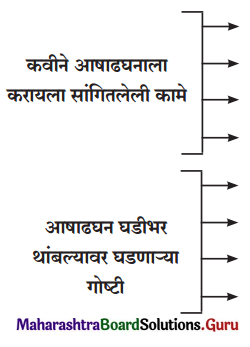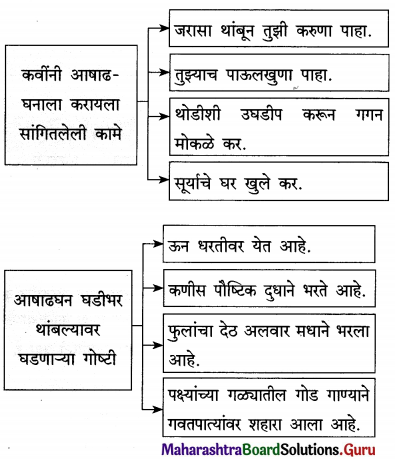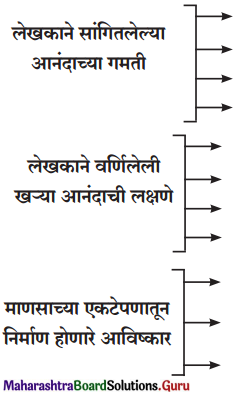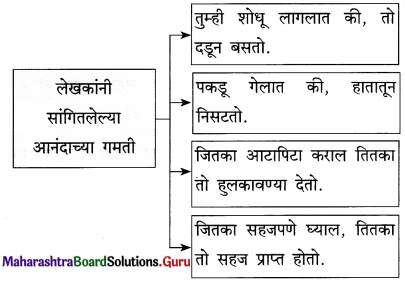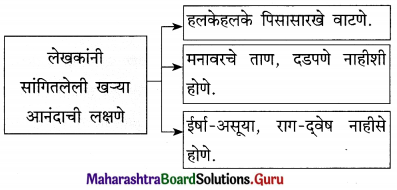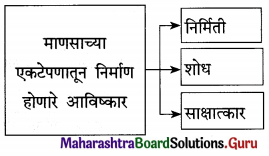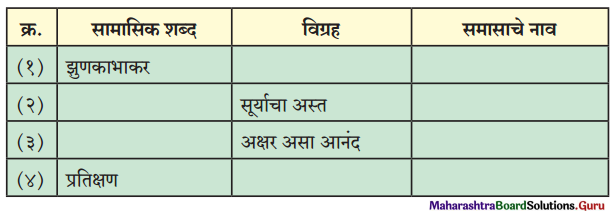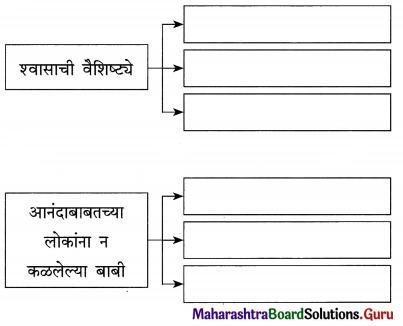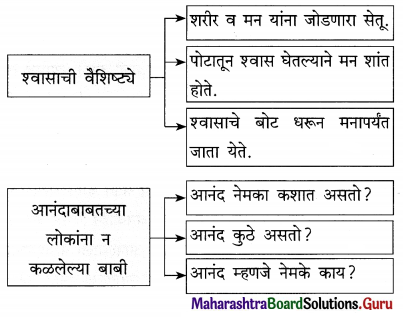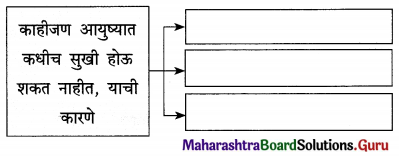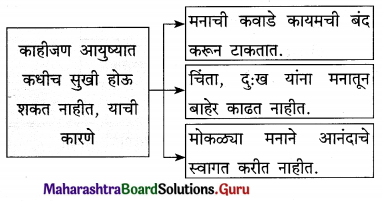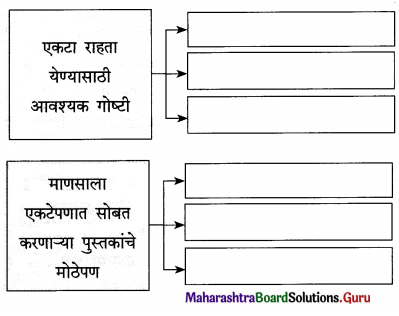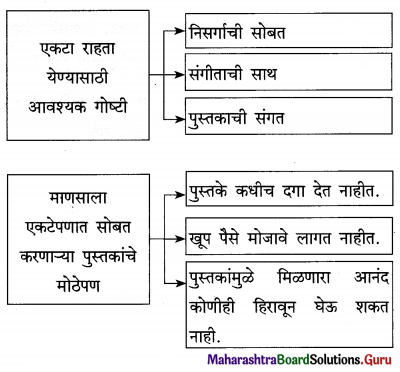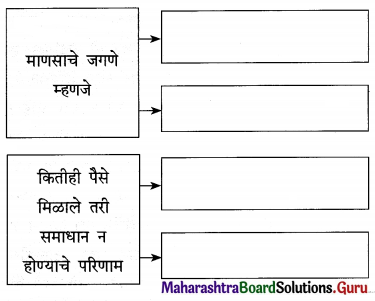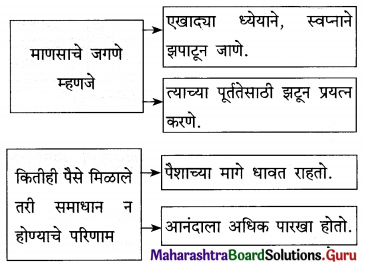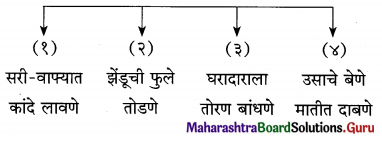Balbharti Maharashtra State Board Marathi Yuvakbharati 12th Digest Chapter 10 दंतकथा Notes, Textbook Exercise Important Questions and Answers.
12th Marathi Chapter 10 Exercise Question Answer Maharashtra Board
दंतकथा 12 वी मराठी स्वाध्याय प्रश्नांची उत्तरे
12th Marathi Guide Chapter 10 दंतकथा Textbook Questions and Answers
कृती
1. अ. कारणे शोधा व लिहा.
प्रश्न 1.
लेखकाला दातांबद्दल अजिबात प्रेम नाही, कारण ………
उत्तर :
लेखकांना दातांबद्दल अजिबात प्रेम नाही; कारण लहानपणी दात येत असताना त्यांनी घरातल्या माणसांना रडवले होते आणि त्यांच्यावरही रडण्याची पाळी आली होती.
![]()
प्रश्न 2.
दातदुखीच्या काळात दाते किंवा दातार यांना भेटू नये असे लेखकाला वाटते, कारण ………
उत्तर :
दातदुखीच्या काळात दाते किंवा दातार यांना भेटू नये, असे लेखकांना वाटते; कारण त्यांची सहनशक्ती पूर्णपणे संपली होती आणि दातांशी नावानेसुद्धा जवळीक असलेल्या व्यक्तींना भेटण्याची त्यांना इच्छा नव्हती.
आ. कृती करा.
प्रश्न 1.

उत्तर :
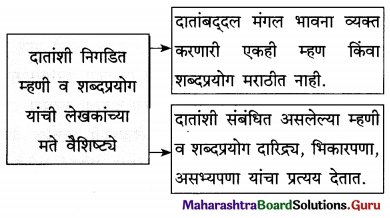
प्रश्न 2.
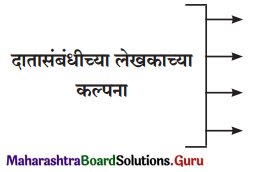
उत्तर :
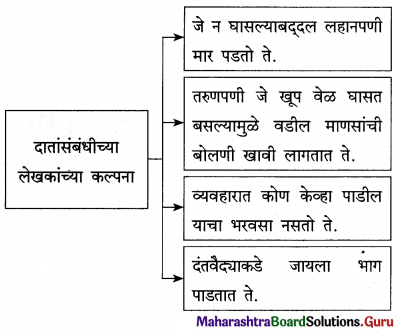
प्रश्न 3.
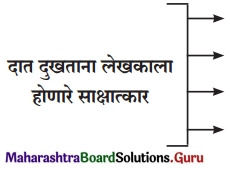
उत्तर :
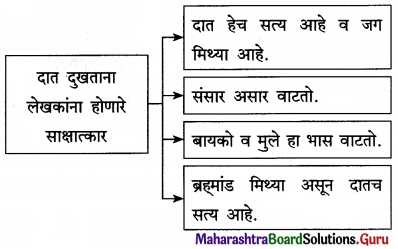
इ. स्वभाववैशिष्ट्ये लिहा.
प्रश्न 1.
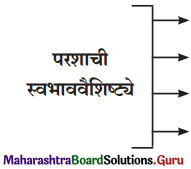
उत्तर :
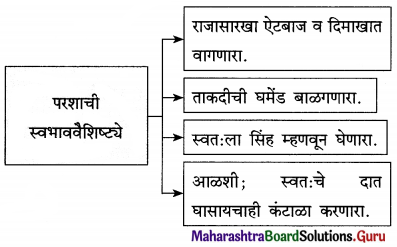
प्रश्न 2.
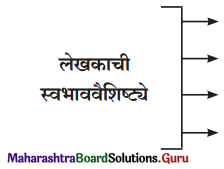
उत्तर :
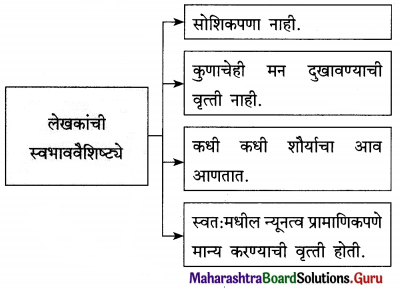
2. चौकटी पूर्ण करा.
प्रश्न 1.
अ. लेखकाच्या मते सहावे महाभूत. [ ]
आ. लेखकाने दुखऱ्या दाताला दिलेली उपमा. [ ]
इ. ऐटीत चालणारा परशा म्हणजे जणू. [ ]
ई. लेखकाच्या मते जन्मात एकही दात न दुखणारा माणूस असा असतो. [ ]
उ. लेखकाच्या मते कवीने दाताला दिलेली उपमा. [ ]
उत्तर :
अ. लेखकाच्या मते सहावे महाभूत. दात
आ. लेखकाने दुखऱ्या दाताला दिलेली उपमा. राक्षस
इ. ऐटीत चालणारा परशा म्हणजे जणू. वनराज
ई. लेखकाच्या मते जन्मात एकही दात न दुखणारा माणूस असा असतो. कमनशिबी
उ. लेखकाच्या मते कवीने दाताला दिलेली उपमा. कुंदकळ्यांची
3. व्याकरण.
अ. खालील वाक्यांतील प्रयोग ओळखा व लिहा.
प्रश्न 1.
चार दिवसांनी दात दुखायचा थांबतो-
उत्तर :
चार दिवसांनी दात दुखायचा थांबतो – कर्तरी प्रयोग
प्रश्न 2.
सगळे खूष होतात-
उत्तर :
सगळे खूष होतात – कर्तरी प्रयोग
![]()
प्रश्न 3.
त्याने माझ्या हिरड्यांत इंजेक्शन दिले-
उत्तर :
त्याने माझ्या हिरड्यांत इंजेक्शन दिले – कर्मणी प्रयोग
प्रश्न 4.
डॉक्टरांनी लीलया दात उपटला-
उत्तर :
डॉक्टरांनी लीलया दात उपटला – कर्मणी प्रयोग
आ. खालील तक्ता पूर्ण करा.
प्रश्न 1.
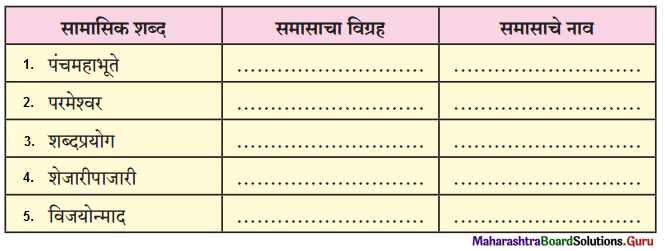
उत्तर :
| सामासिक शब्द | समासाचा विग्रह | समासाचे नाव |
| 1. पंचमहाभूते | पाच महाभुतांचा समूह | द्विगू |
| 2. परमेश्वर | परम असा ईश्वर | कर्मधारय |
| 3. शब्दप्रयोग | शब्दाचा प्रयोग | विभक्ती तत्पुरुष |
| 4. शेजारीपाजारी | शेजारी, पाजारी वगैरे | समाहार द्वंद्व |
| 5. विजयोन्माद | विजयाचा उन्माद | विभक्ती तत्पुरुष |
इ. खालील वाक्यात दडलेला वाक्प्रचार शोधा व लिहा.
प्रश्न 1.
माणसाला शरण आणताना तृण धरायला एखादी चांगली जागा असावी, म्हणून दातांची योजना झालेली आहे.
उत्तर :
वाक्प्रचार → दाती तृण धरणे.
![]()
ई. खालील वाक्यांचे कंसातील सूचनेनुसार वाक्यपरिवर्तन करा.
प्रश्न 1.
- परशाने प्रश्न नम्रपणे विचारला नव्हता. (होकारार्थी करा.)
- शिंव्हाला काय भ्या हाय व्हय कुणाचं? (विधानार्थी करा.)
- तुझ्या अंगात लई हाडं हैत. (उद्गारार्थी करा.)
उत्तर :
- परशाने प्रश्न उद्धटपणे विचारला होता.
- शिंव्हाला कुणाचचं भ्या नाही.
- किती हाडं हैत तुझ्या अंगात!
4. स्वमत.
प्रश्न अ.
पाठातील विनोद निर्माण करणारी पाच वाक्ये शोधा. ती तुम्हांला का आवडली ते सकारण लिहा.
उत्तर :
दंतकथा हा वसंत सबनीस यांचा बहारदार विनोदी लेख आहे. दातदुखी हा तसे पाहिले तर कारुण्यपूर्ण, वेदनादायक आणि गंभीर असा विषय. पण लेखकांनी नर्मविनोद, प्रसंगनिष्ठ विनोद, अतिशयोक्ती, कोट्या अशा अनेक साधनांच्या साहाय्याने अत्यंत प्रसन्न व वाचनीय असा लेख निर्माण केला आहे. त्यातली काही उदाहरणे आपण पाहू.
मराठी भाषेलाही दातांबद्दल आदर नाही; कारण मराठी भाषेत अशी म्हण किंवा शब्दप्रयोग नाही ज्यांत दातांबद्दल मंगल भावना व्यक्त झाली आहे. लेखकांची ही दोन वाक्ये पाहा. त्यांना दातदुखीचा खूपच त्रास झाला होता. यामुळे त्यांच्या मनात दातांबद्दल प्रेम नाही. किंबहुना काहीसा रागच आहे. हा राग व्यक्त करण्यासाठी त्यांनी मराठी भाषेचा किती चपखल उपयोग केला आहे पाहा. मराठी भाषेत दातांबद्दल मंगल भावना व्यक्त करणारी म्हण नाही. हे त्यांचे म्हणणे पहिल्यांदा वाचताना जरा गंमत वाटते. थोडे बारकाईने पाहिल्यावर, अनेक म्हणी आठवल्यावर लेखकांचे म्हणणे खरे असल्याचे लक्षात येते.
डोळे, रंग, ओठ, एखादा तीळ, एखादी खळी माणसाला गुंतवतात; पण दात पाहून वेडा झालेला प्रियकर मला अजून भेटायचा आहे. हेसुद्धा एक गमतीदार वास्तव आहे. लेखकांच्या सूक्ष्म निरीक्षणशक्तीचा येथे प्रत्यय येतो. दात पाहून वेडा झालेला प्रियकर हा उल्लेख नुसता वाचताक्षणी हसू आल्याशिवाय राहत नाही.
दातदुखीतल्या ठणक्याची तीव्रता सांगताना लेखकांनी दिलेले उदाहरण लक्षणीय आहे. ते लिहितात, “एखादा लाकूडतोड्या माझ्या दाताच्या मुळाशी खोल बसलेला असतो आणि तो एकामागून एक घाव घालीत असतो.” हा दाखलासुद्धा अप्रतिम आहे. हे उदाहरण चमत्कृतीपूर्ण आहे. दातदुखीच्या वेदनेचा ठणका हे उदाहरण वाचतानाही आपण अनुभव. लेखकांचे हे विनोद निर्मितीचे कौशल्य विलक्षणच आहे.
![]()
प्रश्न आ.
लेखकाने दुखऱ्या दाताची तुलना अक्राळविक्राळ राक्षसाशी केलेली आहे, याबाबत तुमचे मत लिहा.
उत्तर :
दातदुखीच्या भयानक वेदनांचा अनुभव तसा सगळ्यांनाच परिचयाचा आहे. त्या वेदना सहन करण्याच्या पलीकडच्या असतात. बोंबा मारणे याखेरीज दुसरा मार्गच नसतो. हाताला, पायाला किंवा डोक्याला कुठेही जखम झाली, तर मलमपट्टी करता येते. दातदुखीबाबत मात्र काहीही करता येत नाही. डोके दुखत असेल, अंग दुखत असेल, तर शेक दिल्यावर जरा आराम पडतो. डोके दाबून दिले, अंग जरा रगडले, पाय चेपून दिले, तर बरे वाटते. दातदुखीबाबत मात्र यातला कोणताच उपाय उपयोगी येत नाही.
दातदुखीच्या प्रसंगातील लेखकांचे निरीक्षण मात्र बहारीचे आहे. ते इतके अचूक आहे की, स्वतःची दातदुखी आठवू लागते. दातदुखी, दाढदुखी ठणके जीवघेणे असतात. आपल्या दाढेच्या मुळाशी एखादा लाकूडतोड्या बसून एकामागून एक दातांच्या मुळावर घाव घालीत तर नाही ना, असे वाटत राहते. डॉक्टरांनी दिलेल्या औषधाने काही क्षण थोडे बरे वाटते. पण तेवढ्यात जीवघेणे ठणके सुरू होतात. प्रत्येक ठणक्याबरोबर वेदना कपाळात शिरते आणि ती डोके फोडून बाहेर पडेल, असे वाटत राहते. वेदनेचे स्वरूप अवाढव्य असते. तिला राक्षसाखेरीज अन्य कोणतीही उपमा लागू पडत नाही.
दिवस कसाबसा जातो. पण रात्री मात्र छातीत धडकी भरायला सुरुवात होते. आता रात्री ठणके मारू लागले तर? या कल्पनेनेच जीव अर्धमेला होतो. ठणके सुरू झाल्यावर मात्र बोंबा मारण्याखेरीज आपल्या हातात काहीही राहत नाही. रात्री वाहन मिळत नाही. डॉक्टरांचा दवाखाना बंद असतो. हॉस्पिटल कुठेतरी खूप दूर असते. भीतीने जीव अर्धा जातो. डोक्यात घणाचे घाव पडत असतात. अन्य लोक आपल्याला मदत करू शकतात. पण ते आपल्या वेदना घेऊ शकत नाहीत. त्या वेदना सहन करणाऱ्यालाच लेखकांनी दातदुखीला दिलेली अक्राळविक्राळ राक्षसाची उपमा कळू शकेल.
प्रश्न इ.
लेखकाच्या दातदुखीबाबत शेजाऱ्यांनी दिलेल्या प्रतिक्रियांच्या संदर्भात एक छोटे टिपण तयार करा.
उत्तर :
आपला देश परंपराप्रिय आहे. अनेक परंपरा आपण प्राणपणाने जपतो. या परंपरांमधली एक आहे आजारी माणसाला भेटायला जाणे. एखादा माणूस जर हॉस्पिटलमध्ये दाखल झाला, तर मग काही विचारायलाच नको. लोक जथ्याजथ्याने आजारी माणसाला भेटायला जातात. यामागची कल्पना अशी की, आजारामध्ये माणूस कमकुवत बनतो. मानसिक दृष्टीनेही थोडा कमकुवत बनतो. या काळात आजारी माणसाला धीर दिला पाहिजे, शुभेच्छा दिल्या पाहिजेत, या समजुतीनेही भेटायला जातात. आपण आजाऱ्यासोबत थोडा वेळ बसलो, गप्पागोष्टी केल्या तर त्याला विरंगुळाही मिळतो. हे असेच घडले तर ते चांगलेच आहे.
प्रत्यक्षात काय दिसते? माणसे भेटायला जातात. पण गप्पागोष्टी काय करतात? थोड्या इकडच्या तिकडच्या गोष्टी झाल्या की, गप्पांची गाडी आजारी व्यक्तीच्या रोगावरच येते. मग त्या रोगांसंबंधात नको नको त्या गोष्टी चर्चिल्या जातात. रोग कसा भयंकर आहे, किती त्रास होतो, नुकसान कसकसे होत जाते, काही माणसे कशी दगावली आहेत इत्यादी इत्यादी. या गप्पांमुळे आजारी व्यक्तीचे मनोबल वाढण्याऐवजी त्याचे खच्चीकरण होते. त्याची चिंता वाढते, तो नकारात्मक दृष्टीने विचार करू लागतो. तो मानसिकदृष्ट्या खचतो. अशा स्थितीत आजाराशी लढण्याची उमेद कमी होते. याचा प्रकृती सुधारण्यावर विपरीत परिणाम होतो.
माणसे हॉस्पिटलमध्ये भेटायला जातात, तेव्हा वेळ मर्यादित असतो. तो ठरावीक कालावधीतच असतो. त्या वेळी ठीक असते. पण आजारी व्यक्ती घरी असली, तर माणसे कधीही, कितीही वाजता आजारी व्यक्तीच्या घरी थडकतात. कितीही वेळ बोलत बसतात. त्या व्यक्तीची अन्य काही कामे आहेत का, घरच्यांच्या काही अडचणी आहेत का, घरच्यांपैकी कोणाला बाहेर जायचे आहे का, विश्रांतीची वेळ आहे का, वगैरे वगैरे अनेक गोष्टी असतात. त्यांचा कोण विचार करीत नाहीत. आजारी व्यक्तीला अडचणीत आणतात. खरे तर आजारी व्यक्तीला अन्य व्यक्तींचा कमीत कमी संसर्ग झाला पाहिजे. पण हे पथ्य तर कोणी पाळतच नाहीत. आजारी व्यक्तींना भेटण्यासंबंधात काही एक पथ्ये, नियम करून त्यांचा प्रचार करणे खूप गरजेचे आहे.
![]()
5. अभिव्यक्ती.
प्रश्न 1.
प्रस्तुत पाठ तुम्हांला आवडण्याची वा न आवडण्याची कारणे लिहा.
उत्तर :
पाठ्यपुस्तकात वेगवेगळे पाठ आहेत. त्यांपैकी ‘दंतकथा’ हा विनोदी पाठ मला खूप आवडला. पुन्हा पुन्हा वाचून मी आनंद घेतला. लेखक आहेत वसंत सबनीस.
वास्तविक दातदुखी हा अत्यंत वेदनादायक, माणसाला असहाय करणारा प्रसंग. त्या प्रसंगावर हा लेख आधारलेला आहे. मात्र लेखक त्या प्रसंगाकडे कारुण्यपूर्ण नजरेने न पाहता एका गमतीदार, खेळकर दृष्टीने पाहतात. घटनेकडे पाहण्याचा कोनच बदलल्यामुळे घटनेचे रूपच बदलून जाते. त्यामुळे माणसाच्या वागण्यातील हास्यास्पद, विसंगती अधिक ठळकपणे लक्षात येतात. हे बदललेले रूप लेखकांनी नर्मविनोदी शैलीत चित्रित केले आहे.
प्रसंग खेळकर, तिरकस नजरेने पाहिल्यामुळे, नर्मविनोदी शब्दयोजनेमुळे वाचकाच्या चेहेऱ्यावर स्मित रेषा उमटतेच. कधी कधी वाचक खळखळून हसतो. लेखकांनी मनुष्यस्वभावाचे नमुने मार्मिकपणे टिपले आहेत. तसेच विसंगतीही वाचकांना हसवत हसवत दाखवून दिल्या आहेत. दातदुखीच्या वेळी वास्तवात घडणारे प्रसंग अतिशयोक्तीचा बहारदार वापर करीत वर्णिले आहेत. म्हणी-वाक्प्रचारांवर कोटी करून गमती साधलेल्या आहेत. शाब्दिक कोट्यांचा सुरेख वापर केला आहे. यांमुळे संपूर्ण लेख चुरचुरीत, वाचनीय झाला आहे.
एक-दोन उदाहरणे पाहू. लेखाच्या सुरुवातीलाच दाताची पंचमहाभूतांशी सांगड घातली आहे. पंचमहाभूते ही संपूर्ण विश्वाच्या रचनेतील मूलभूत तत्त्वे आहेत. तर दात हा एक माणसाचा सामान्य अवयव. या दाताला लेखकांनी सहावे महाभूत म्हटले आहे. अत्यंत सामान्य गोष्टी महान दर्जा दिल्यामुळे गमतीदार विरोधाभास निर्माण झाला. पुढच्याच परिच्छेदात, परमेश्वराला दाताची कल्पना सहा-सात महिन्यांनंतर सुचली असावी, असा लेखकांनी उल्लेख केला. हे वाचताक्षणी हसू येते. परमेश्वर सर्वशक्तिमान, परिपूर्ण. तरीही दातांची कल्पना उशिरा सुचल्याचे लिहून लेखकांनी ईश्वराला माणसाच्या जवळ आणले. त्यामुळे इथेही एक गमतीदार विरोधाभास निर्माण होतो.
भाषेतील निरीक्षणही बहारीचे आहे. दातासंबंधात एकही मंगलमय म्हण वा वाक्प्रचार मराठीत नाही. दातांवरून ज्या म्हणी-वाक्प्रचार आहेत, त्या दारिद्र्य, भिकारपणा व असभ्यपणा यांचा निर्देश करणाऱ्या आहेत. हा उल्लेख भाषेला खमंगपणा आणतो. ‘दात पाहून प्रेयसीसाठी वेडा झालेला प्रियकर’ अजून पाहिला नसल्याचे ते नमूद करतात. या अशा उल्लेखांमुळे लेखाला खेळकरपणा चुरचुरीतपणा व गमतीदारपणा प्राप्त झाला आहे. कोणत्याही वाचकाला तो सहज आवडेल असा आहे.
![]()
उपक्रम :
डोळे व नाक या अवयवांशी संबंधित वाक्प्रचारांची यादी करा.
तोंडी परीक्षा.
खालील वाक्प्रचारांचे अर्थ सांगून वाक्यात उपयोग करा.
- नक्षा उतरणे
- शंख करणे
- दात घशात घालणे
- खल करणे
- चारीमुंड्या चीत होणे
- सिंहाचा बकरा होणे
- मेख मारणे
Marathi Yuvakbharati 12th Digest Chapter 10 दंतकथा Additional Important Questions and Answers
कारणे शोधा व लिहा :
प्रश्न 1.
लेखकांच्या मते, मानवी देहाची परिपूर्ण रचना केल्यानंतर जवळजवळ सहा-सात महिन्यांनी ही दातांची कल्पना परमेश्वराला सुचली असावी; कारण –
लेखकांच्या मते, मराठी भाषेलाही दातांबद्दल आदर दिसत नाही; कारण –
आपण हाडांच्या मजबुतीबाबत तरी परशाच्या वरचढ आहोत, याचा लेखकांना आनंद अधिक वाटायचा; कारण –
परशा चार-आठ दिवसांतून एकदा केव्हातरी दात घासण्याचे सोंग करायचा; कारण –
उत्तर :
लेखकांच्या मते, मानवी देहाची परिपूर्ण रचना केल्यानंतर जवळजवळ सहा-सात महिन्यांनी ही दातांची कल्पना परमेश्वराला सुचली असावी; कारण माणसाला जन्मत:च सर्व अवयव फुटतात; पण फक्त दातच जन्मानंतर सहा-सात महिन्यांनी येतात.
लेखकांच्या मते, मराठी भाषेलाही दातांबद्दल आदर दिसत नाही; कारण मराठी भाषेत दातांबद्दल मंगल भावना व्यक्त करणारी एकही म्हण किंवा वाक्प्रचार आढळत नाही.
आपण हाडांच्या मजबुतीबाबत तरी परशाच्या वरचढ आहोत, याचा लेखकांना आनंद अधिक वाटायचा; कारण परशा स्वतःला लेखकांपेक्षा प्रचंड ताकदवान समजायचा आणि येताजाता लेखकांची मानहानी करायचा.
परशा चार-आठ दिवसांतून एकदा केव्हातरी दात घासण्याचे सोंग करायचा; कारण परशाला दात घासायचा कंटाळा यायचा.
![]()
कृती करा :
प्रश्न 1.
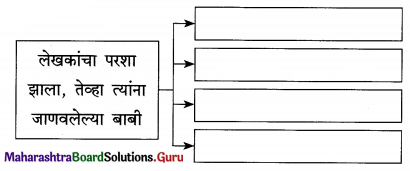
उत्तर :
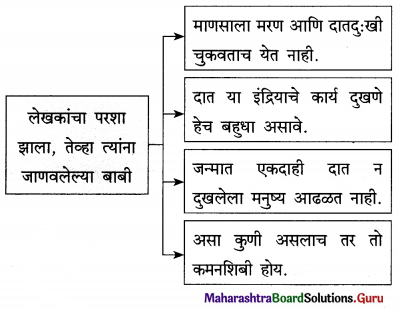
चौकटी पूर्ण करा :
प्रश्न 1.
- परशाने लेखकांच्या हाडांना दिलेली उपमा [ ]
- परशा स्वत:ला म्हणवून घ्यायचा [ ]
- परशाची सपाटून मार खाल्लेल्या कुत्र्यासारखी अवस्था करणारा [ ]
उत्तर :
- परशाने लेखकांच्या हाडांना दिलेली उपमा – दगडाची
- परशा स्वत:ला म्हणवून घ्यायचा – शिव्ह (सिंह)
- लेखकांच्या मते, जन्मात एकही दात न दुखणारा माणूस असा असतो – कमनशिबी
कारणे शोधा व लिहा :
प्रश्न 1.
आपल्या दाताला मूळ नसून झाडासारख्या मुळ्या असल्या पाहिजेत आणि त्या हिरड्यांत सर्वत्र पसरल्या असल्या पाहिजेत, असे लेखकांना वाटते; कारण –
उत्तर :
आपल्या दाताला मूळ नसून झाडासारख्या मुळ्या असल्या पाहिजेत आणि त्या हिरड्यांत सर्वत्र पसरल्या असल्या पाहिजेत, असे लेखकांना वाटते; कारण त्यांचे सर्व दात दुखत असल्याचा त्यांना भास होत होता.
प्रश्न 2.
दातदुखीवरील परिसंवादात लेखकांचे विव्हळणे बुडून जाते; कारण –
उत्तर :
दातदुखीवरील परिसंवादात लेखकांचे विव्हळणे बुडून जाते; कारण हजर असलेले सगळेच जण इतके मोठमोठ्याने बोलत की लेखकांचे विव्हळणे ऐकूही येत नसे.
![]()
प्रश्न 3.
दातदुखी थांबल्यावर लेखक प्रत्येकाला त्याच्याच उपायाने दातदुखी थांबल्याचे सांगतात; कारण –
उत्तर :
दातदुखी थांबल्यावर लेखक प्रत्येकाला त्याच्याच उपायाने दातदुखी थांबल्याचे सांगतात; कारण लेखक कोणालाही दुखवू इच्छित नव्हते.
वैशिष्ट्ये लिहा :
प्रश्न 1.
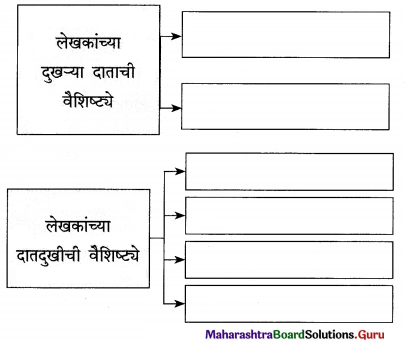
उत्तर :
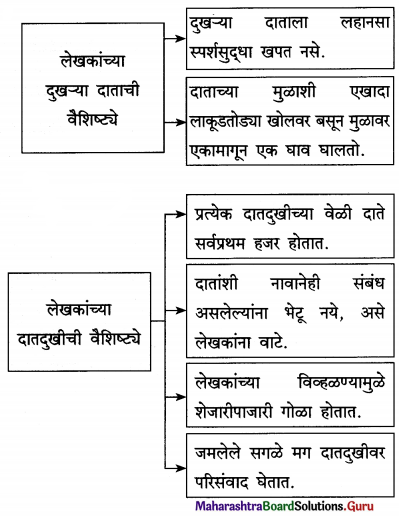
पुढील कोष्टक पूर्ण करा :
प्रश्न 1.
| दिवसा सभ्य दिसणारा माणूस | दुखरा दात | |
| दिवसा | ||
| रात्री |
उत्तर :
| दिवसा सभ्य दिसणारा माणूस | दुखरा दात | |
| दिवसा | सभ्यपणे वागतो. | सभ्यपणे हळूहळू दुखत राहतो. |
| रात्री | रात्री खरा (म्हणजे वाईट) वागतो. | रात्री राक्षसासारखा अक्राळविक्राळ होतो. |
![]()
चौकटी पूर्ण करा :
प्रश्न 1.
- दाताच्या ठणक्यामुळे लेखकांना दिसू लागते ते [ ]
- रात्रीच्या वेळीच गडबड करणारे दोघे [ ]
- दातांशी जवळीक दाखवणारी दोन नावे [ ]
उत्तर :
- दाताच्या ठणक्यामुळे लेखकांना दिसू लागते ते – ब्रह्मांड
- रात्रीच्या वेळीच गडबड करणारे दोघे – चोर आणि दुखरा दात
- दातांशी जवळीक दाखवणारी दोन नावे – दाते व दातार
व्याकरण
वाक्यप्रकार :
वाक्यांच्या आशयावरून वाक्याचे प्रकार ओळखा :
प्रश्न 1.
- दात हे एखादया सभेच्या मुख्य पाहुण्यासारखे मागाहून का यावेत? → [ ]
- बापरे! दात येताना ताप आणि गेल्यावर पश्चात्ताप! → [ ]
- मानवी देह पंचमहाभूतांचा बनला आहे. → [ ]
उत्तर :
- प्रश्नार्थी वाक्य
- उद्गारार्थी वाक्य
- विधानार्थी वाक्य
क्रियापदाच्या रूपांवरून वाक्यप्रकार ओळखा :
प्रश्न 1.
- दात दुखणे सरळ असावे → [ ]
- जेव्हा माझा दात दुखायला लागला, तेव्हा माझी खात्री झाली. → [ ]
- सहाव्या महाभूताला ‘दात’ म्हणतात. → [ ]
- दाताचे दुखणे तू सहन कर. → [ ]
उत्तर :
- विध्यर्थी वाक्य
- संकेतार्थी वाक्य
- स्वार्थी वाक्य
- आज्ञार्थी वाक्य
![]()
अलंकार :
पुढील ओळीतील अलंकार ओळखा :
प्रश्न 1.
1. ओठ कशाचे? देठचि फुलल्या पारिजाताचे। → ………
2. होई जरी सतत दुष्टसंग
न पावती सज्जन सत्त्वभंग
असोनिया सर्प सदा शरीरी
झाला नसे चंदन तो विषारी → ………
उत्तर :
1. अपन्हुती अलंकार
2. अर्थातरन्यास अलंकार.
दंतकथा Summary in Marathi
पाठ परिचय :
‘दंतकथा’ हा एक विनोदी लेख आहे. दातदुखी या अनुभवाकडे लेखक खेळकर, गमतीदार नजरेने पाहतात. त्या अनुभवाचे घडवलेले दर्शन म्हणजे हा लेख होय. हे दर्शन घडवता घडवता त्यांनी मानवी जीवनातील विसंगतीकडेही बोट दाखवले आहे.
दातदुखी हा जीवनातील एक वेदनामय असा अनुभव. या अनुभवाच्या वेदनामय भागाकडे लेखकांचे लक्ष नाही, त्यांचा रोख मानवी स्वभावातील विसंग:कडे आहे.
सुरुवातीला लेखक दातांचे महत्त्व सांगण्याचा पवित्रा घेतात. दात हा अवयव पंचमहाभूतासारखेच एक सहावे महाभूत आहे असे सांगतात, पंचमहाभूते म्हणजे विश्वरचनेची पाच मूलतत्त्वे होत. दात तसेच एक मूलतत्त्व असूनही लेखक त्याला महत्त्व देत नाहीत. मराठी भाषेतही दाताला महत्त्व नाही. कारण दाताविषयी मंगल भावना व्यक्त करणारी एकही म्हण किंवा शब्दप्रयोग मराठीत नाही. प्रियकर प्रेयसीच्या प्रेमात पडतो तेव्हा डोळे, रंग, ओठ, एखादा तीळ, गालावरची खळी यात त्याचा जीव अडकतो. पण प्रेयसीच्या दाताच्या प्रेमात पडलेला प्रियकर आढळत नाही.
मात्र, दात त्रासदायक ठरू शकतो. शक्तिमान अशा परशा पहिलवानाला दातदुखीने पूर्ण नामोहरम केले. मरण आणि दातदुखी कोणाला चुकवता येत नाही, हे नवीन भान लेखकांना आले.
एके दिवशी लेखकांचा एक दात दुखू लागला. प्रचंड वेदना होऊ लागल्या, एखादा लाकूडतोड्या दाताच्या मुळावर घाव घालत असावा, तसा लेखकांना अनुभव आला.
दातदुखीने लेखकांना हैराण केले. त्यांना रात्रभर विव्हळत राहावे लागले, पण लहान मुलाप्रमाणे मोठमोठ्याने आरडाओरड करणे लेखकांच्या पत्नीला पसंत नव्हते.
दातदुखीच्या बातमीने लेखकांचे शेजारी एकएक करून सगळे तब्येतीच्या चौकशीसाठी जमले. दातदुखीबद्दल चर्चा झाली.’ प्रत्येकाने आपापला उपाय सुचवला. लेखकांनी व त्यांच्या पत्नीने स्वत:चे उपाय करून पाहिले.
अखेरीस लेखकांनी दंतवैदयाकडून दुखरा दात काढून घेतला. त्या वेळी लेखकांची दातदुखीपासून मुक्तता झाली.
शब्दार्थ :
- मेख – खोच, रहस्य, गूढ गोष्ट.
- नकटे (नाक) – कापलेले, आखूड, चपटे, बसके (असे नाक).
- प्रेमविव्हल – प्रेमासाठी व्याकूळ झालेला.
- कुंदकळ्या – कुंदा नावाच्या फुलझाडाच्या कळया.
- (त्या. शुभ्र व सुंदर असतात. सुंदर दातांना त्यांची उपमा देतात.)
- विकट – भयानक, हिडीस, कुरूप.
- अल्याड – अलीकडे.
- ब्रह्मांड – अवकाशातील संपूर्ण विश्व.
- असार – निःसत्त्व, खोटे, निकामी.
- मिथ्या – खोटे, नश्वर, भ्रामक.
- लोकापवाद – अकारण पसरवलेले गैरसमज, आळ.
- आळी – गल्ली, गल्लीच्या आधाराने उभा राहिलेला घरांचा समूह.
- थैमान – रडण्या-ओरडण्याचा प्रचंड कल्लोळ, आदळआपट.
- मतैक्य – एकमत.
- खलदंत – दुष्ट दात.
- नतद्रष्ट – दुष्ट, वाईट (अत्यंत कंजूष.)
![]()
वाक्प्रचार व त्यांचे अर्थ :
- मेख मारणे – एखादया कामात युक्तीने अडचण निर्माण करून ठेवणे.
- दाती तृण धरणे – शरण येणे.
- स्वत:चीच मनगटे चावणे – शत्रूविरुद्ध काहीही करता येत नसल्याने चडफडत बसणे.
- दातांत धरता येणे – सामान्य, क्षुल्लक, किरकोळ वस्तू बाळगणे.
- बोलणी खाणे – दोषारोप, निंदा, ठपका ऐकून घ्यावा लागणे.
- चारीमुंड्या चीत होणे – पुरता पराभव होणे.
- मागमूस नसणे – ठावठिकाणा न आवळणे, चिन्हहीन आढळणे.
- नक्षा उतरणे – ताठा, घमेंड, अभिमान उतरणे.
- साक्षात्कार होणे – ईश्वराचे प्रत्यक्ष दर्शन घडणे, (यावरून एखादया गोष्टीचे मर्म अचानक कळणे.)
- थैमान घालणे – आदळआपट, प्रचंड गोंधळ करणे.
- दात उपटून हातात देणे – घमेंड घालवणारा पराभव करणे.
- दात घशात घालणे – पुरता पराभव करणे.
- शक्तीचे प्रदर्शन करणे – शक्तिमान असल्याचा देखावा करणे.
- हसे करणे – हास्यास्पद करणे.
- दातओठ खाणे – मनात मोठा राग, त्वेष असणे.
- शंख करणे – बोंबाबोंब करणे, आरडाओरड करणे.
- खल करणे – (बहुतेकदा गुप्तपणे) चर्चा करणे.
- सिंहाचा बकरा होणे – सर्व अवसान गळून पडणे.
12th Marathi Guide भाग-२
- विंचू चावला… Question Answer
- रेशीमबंध Question Answer
- समुद्र कोंडून पडलाय Question Answer
- दंतकथा Question Answer
- आरशातली स्त्री Question Answer
- रंगरेषा व्यंगरेषा Question Answer
- जयपूर फूटचे जनक Question Answer

